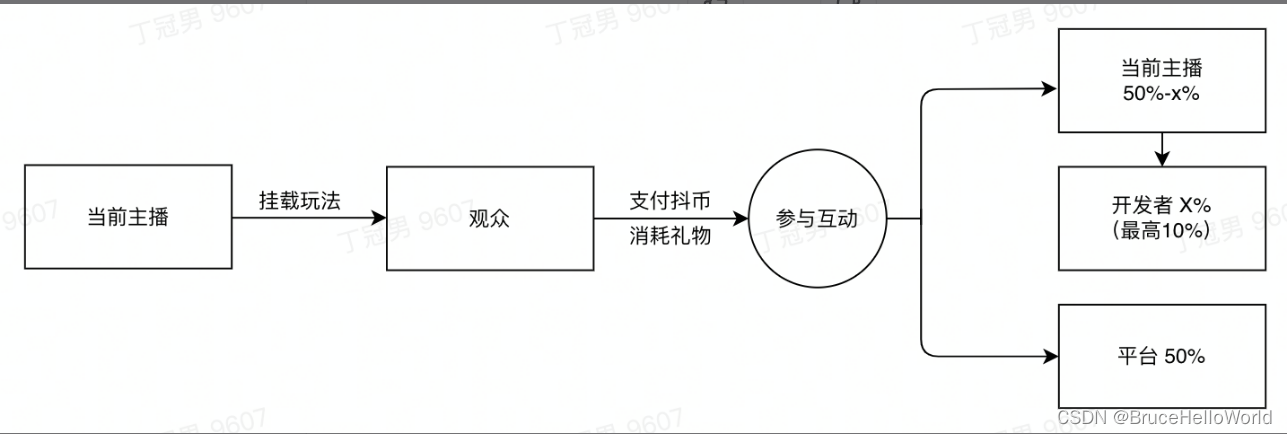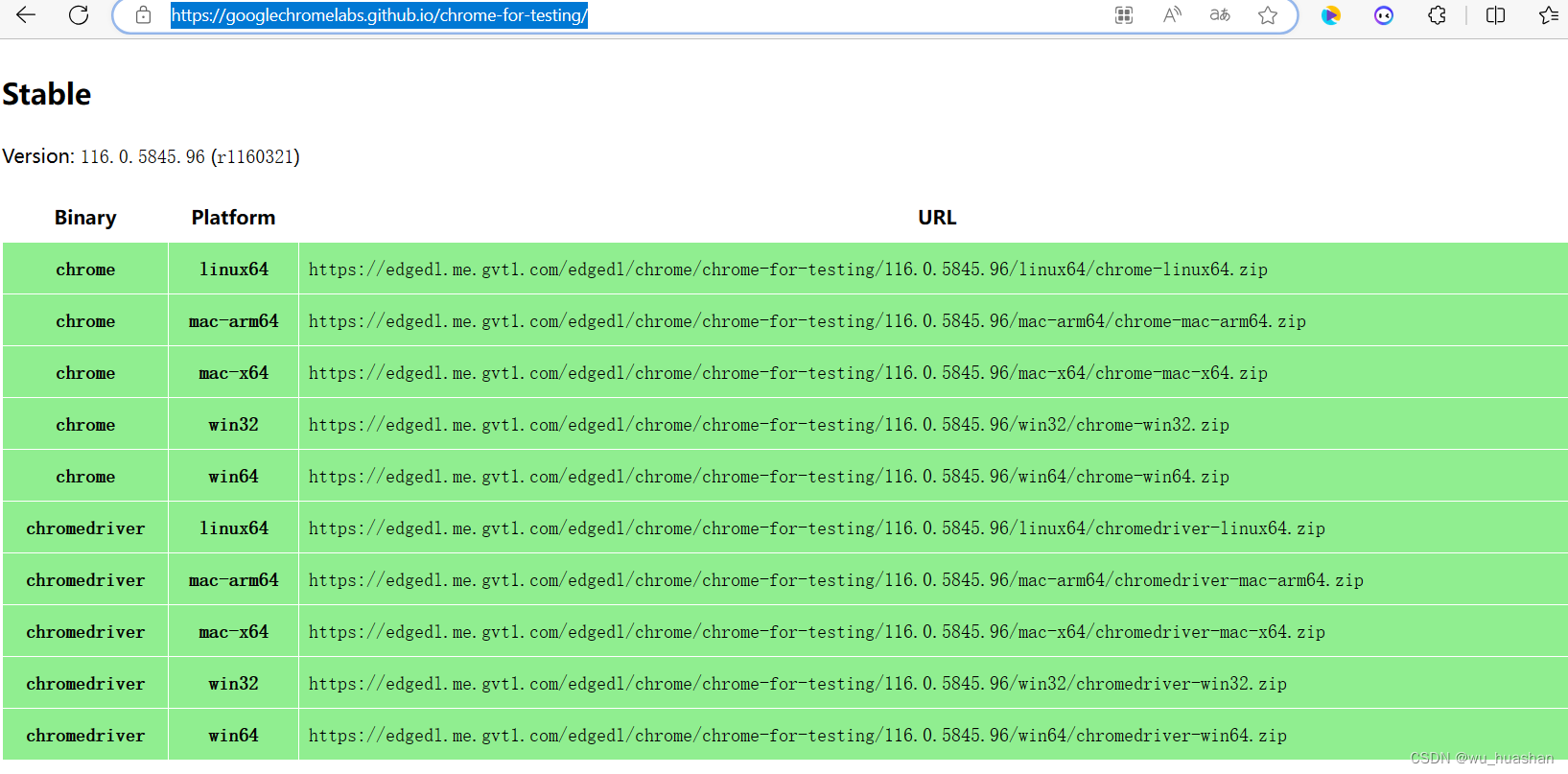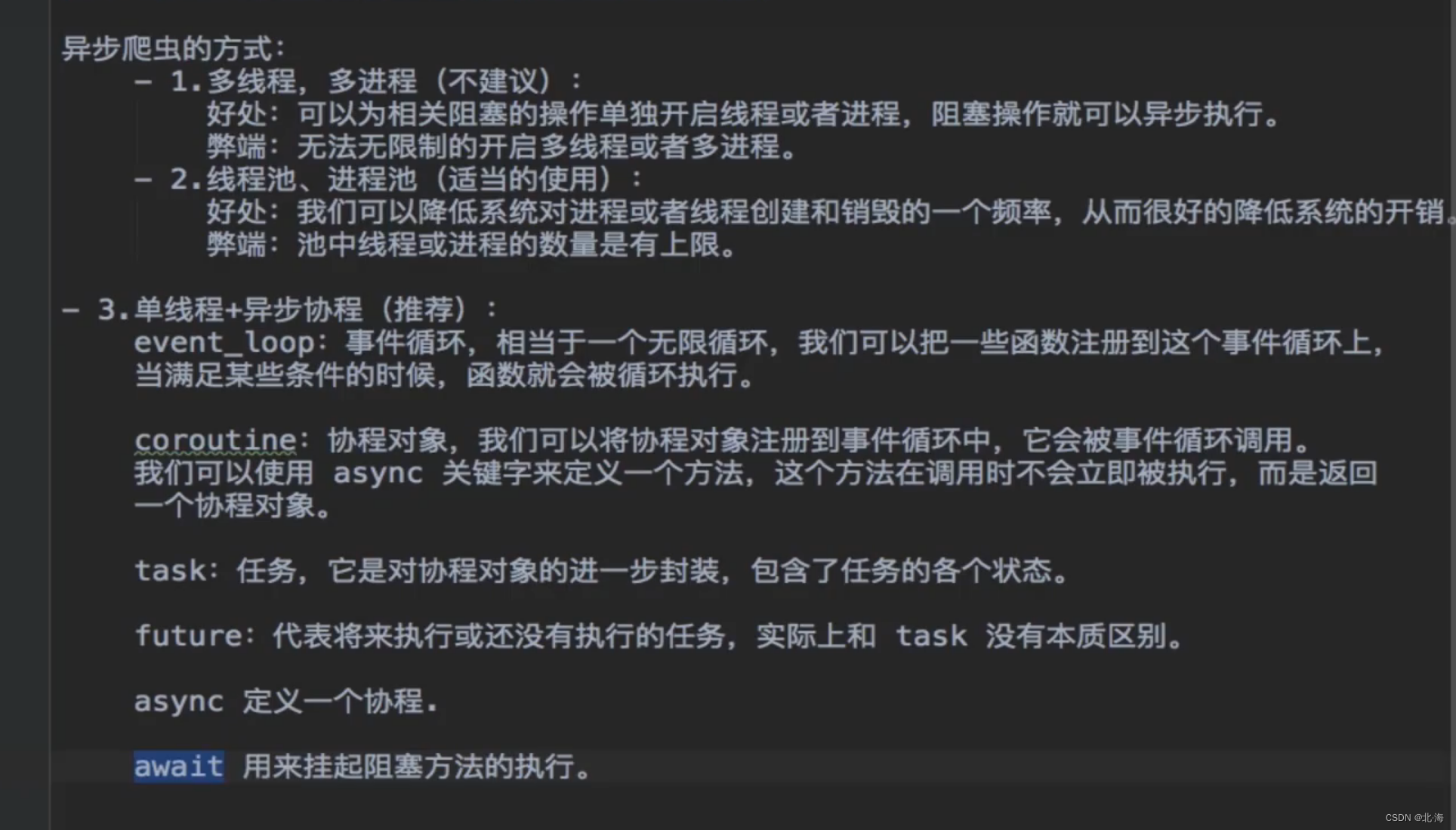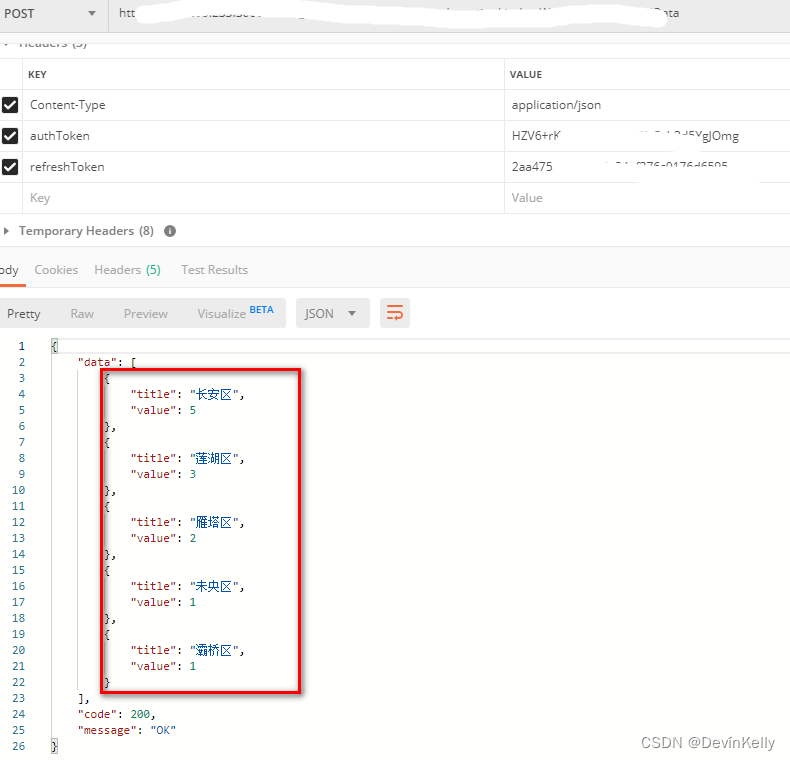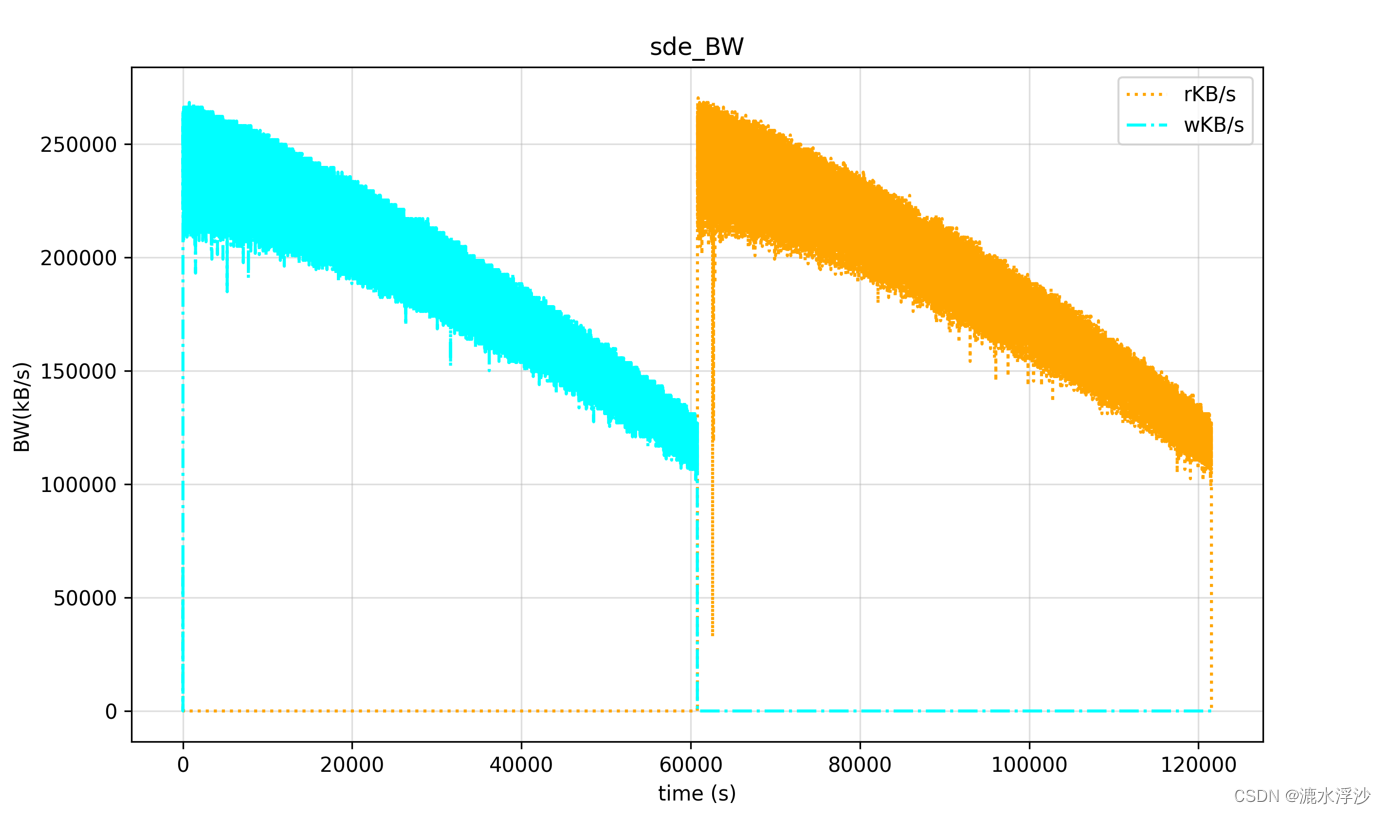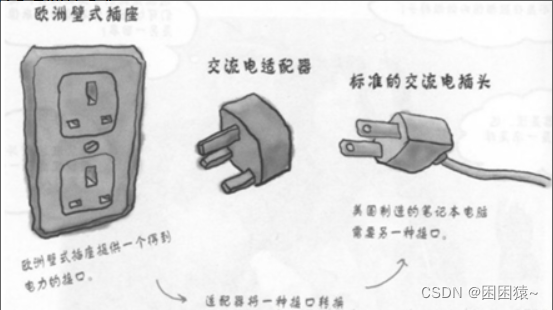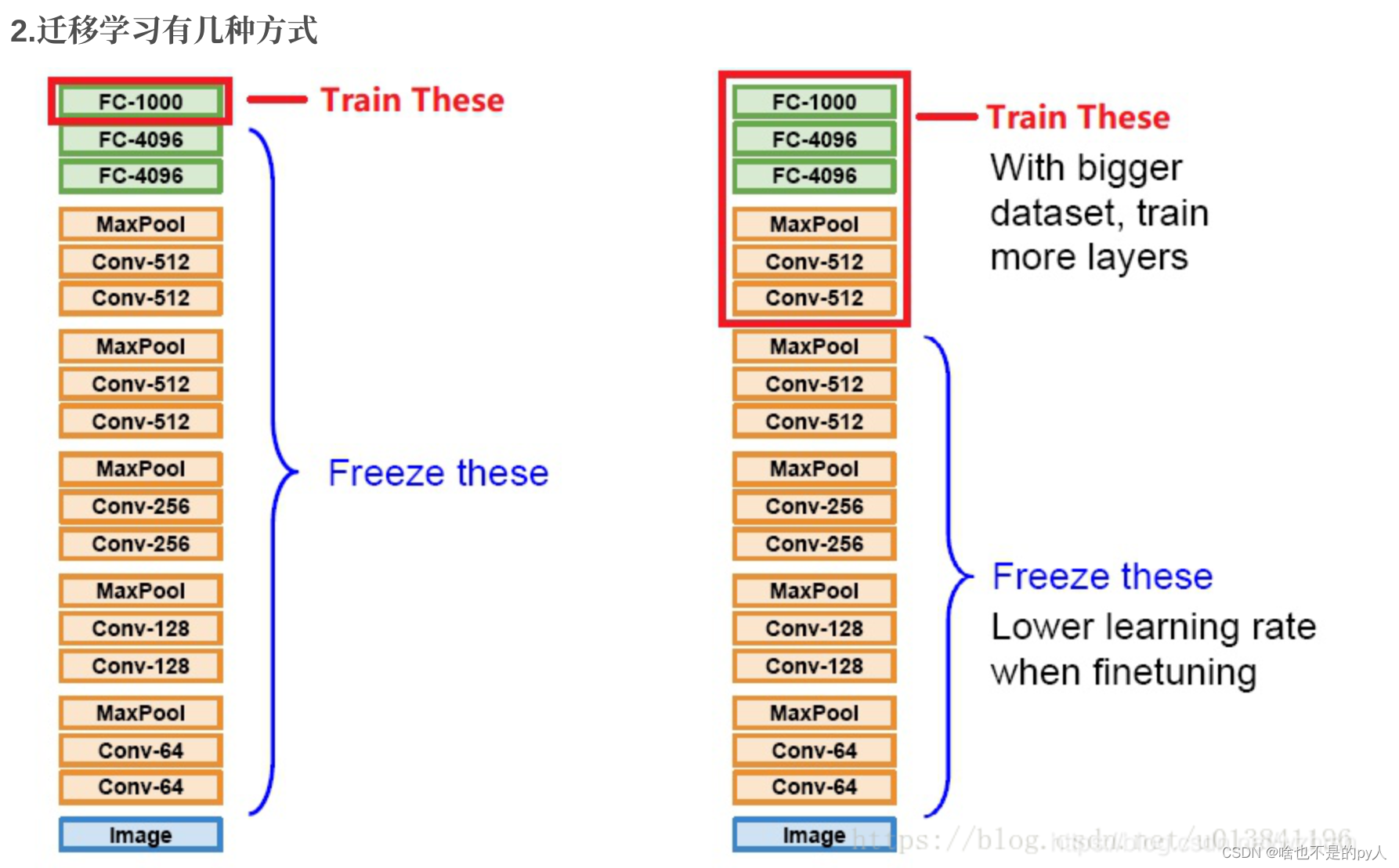[oneAPI] 使用序列到序列网络和注意力进行翻译
- oneAPI特殊写法
- 使用序列到序列网络和注意力进行翻译
- Intel® Optimization for PyTorch
- 导入包
- 加载数据并对数据进行处理
- 序列到序列网络和注意力模型与介绍
- 编码器
- 解码器
- 简单解码器
- 注意力解码器
- 训练过程
- 准备训练数据
- 训练模型
- 可视化注意力代码
- 结果
- 参考资料
比赛:https://marketing.csdn.net/p/f3e44fbfe46c465f4d9d6c23e38e0517
Intel® DevCloud for oneAPI:https://devcloud.intel.com/oneapi/get_started/aiAnalyticsToolkitSamples/
oneAPI特殊写法
import intel_extension_for_pytorch as ipex# Device configuration
device = torch.device('xpu' if torch.cuda.is_available() else 'cpu')encoder_optimizer = optim.Adam(encoder.parameters(), lr=learning_rate)
decoder_optimizer = optim.Adam(decoder.parameters(), lr=learning_rate)'''
Apply Intel Extension for PyTorch optimization against the model object and optimizer object.
'''
encoder, encoder_optimizer = ipex.optimize(encoder, optimizer=encoder_optimizer)
decoder, decoder_optimizer = ipex.optimize(decoder, optimizer=decoder_optimizer)criterion = nn.NLLLoss()
使用序列到序列网络和注意力进行翻译
让神经网络将法语翻译成英语
[KEY: > input, = target, < output]> il est en train de peindre un tableau .
= he is painting a picture .
< he is painting a picture .> pourquoi ne pas essayer ce vin delicieux ?
= why not try that delicious wine ?
< why not try that delicious wine ?> elle n est pas poete mais romanciere .
= she is not a poet but a novelist .
< she not not a poet but a novelist .> vous etes trop maigre .
= you re too skinny .
< you re all alone .
我们的模型通过序列到序列网络的简单但强大的思想实现的,其中两个循环神经网络一起工作将一个序列转换为另一个序列。编码器网络将输入序列压缩为向量,解码器网络将该向量展开为新序列
Intel® Optimization for PyTorch
在本次实验中,我们利用PyTorch和Intel® Optimization for PyTorch的强大功能,对PyTorch进行了精心的优化和扩展。这些优化举措极大地增强了PyTorch在各种任务中的性能,尤其是在英特尔硬件上的表现更加突出。通过这些优化策略,我们的模型在训练和推断过程中变得更加敏捷和高效,显著地减少了计算时间,提高了整体效能。我们通过深度融合硬件和软件的精巧设计,成功地释放了硬件潜力,使得模型的训练和应用变得更加快速和高效。这一系列优化举措为人工智能应用开辟了新的前景,带来了全新的可能性。

导入包
# -*- coding: utf-8 -*-
from __future__ import unicode_literals, print_function, division
from io import open
import unicodedata
import re
import randomimport torch
import torch.nn as nn
from torch import optim
import torch.nn.functional as Fimport numpy as np
from torch.utils.data import TensorDataset, DataLoader, RandomSamplerimport intel_extension_for_pytorch as ipexdevice = torch.device("xpu" if torch.cuda.is_available() else "cpu")
加载数据并对数据进行处理
该项目的数据是一组数千个英语到法语的翻译对。
数据地址 https://download.pytorch.org/tutorial/data.zip
data/eng-fra.txt 请先下载,该文件是制表符分隔的翻译对列表:I am cold. J'ai froid.
与字符级 RNN 教程中使用的字符编码类似,我们将语言中的每个单词表示为一个单热向量,或除单个 1(在单词索引处)之外的由 0 组成的巨大向量。与语言中可能存在的几十个字符相比,单词的数量要多得多,因此编码向量要大得多。然而,我们将数据修剪为每种语言仅使用几千个单词。
准备数据的完整流程是:
- 读取文本文件并分成行,将行分成对
- 标准化文本,按长度和内容过滤
- 从成对的句子中制作单词列表
我们需要每个单词有一个唯一的索引,以便稍后用作网络的输入和目标。为了跟踪所有这些,我们将使用一个名为的==帮助器类Lang==,它具有 word → index ( word2index) 和 index → word ( index2word) 字典,以及每个单词的计数 word2count,稍后将用于替换稀有单词。
######################################################################
# Loading data files
# ==================
SOS_token = 0
EOS_token = 1class Lang:def __init__(self, name):self.name = nameself.word2index = {}self.word2count = {}self.index2word = {0: "SOS", 1: "EOS"}self.n_words = 2 # Count SOS and EOSdef addSentence(self, sentence):for word in sentence.split(' '):self.addWord(word)def addWord(self, word):if word not in self.word2index:self.word2index[word] = self.n_wordsself.word2count[word] = 1self.index2word[self.n_words] = wordself.n_words += 1else:self.word2count[word] += 1
将 Unicode 字符转换为 ASCII,将所有内容变为小写,并修剪大部分标点符号
######################################################################
# The files are all in Unicode, to simplify we will turn Unicode
# characters to ASCII, make everything lowercase, and trim most
# punctuation.
## Turn a Unicode string to plain ASCII, thanks to
# https://stackoverflow.com/a/518232/2809427
def unicodeToAscii(s):return ''.join(c for c in unicodedata.normalize('NFD', s)if unicodedata.category(c) != 'Mn')# Lowercase, trim, and remove non-letter characters
def normalizeString(s):s = unicodeToAscii(s.lower().strip())s = re.sub(r"([.!?])", r" \1", s)s = re.sub(r"[^a-zA-Z!?]+", r" ", s)return s.strip()
为了读取数据文件,我们将文件分成行,然后将行分成对。这些文件都是英语→其他语言,所以如果我们想从其他语言→英语翻译,我添加了标志reverse 来反转对。
######################################################################
# To read the data file we will split the file into lines, and then split
# lines into pairs. The files are all English → Other Language, so if we
# want to translate from Other Language → English I added the ``reverse``
# flag to reverse the pairs.
#def readLangs(lang1, lang2, reverse=False):print("Reading lines...")# Read the file and split into lineslines = open('data/%s-%s.txt' % (lang1, lang2), encoding='utf-8').\read().strip().split('\n')# Split every line into pairs and normalizepairs = [[normalizeString(s) for s in l.split('\t')] for l in lines]# Reverse pairs, make Lang instancesif reverse:pairs = [list(reversed(p)) for p in pairs]input_lang = Lang(lang2)output_lang = Lang(lang1)else:input_lang = Lang(lang1)output_lang = Lang(lang2)return input_lang, output_lang, pairs
序列到序列网络和注意力模型与介绍
序列到序列网络,或 seq2seq 网络,或编码器解码器网络,是由两个称为编码器和解码器的 RNN 组成的模型。编码器读取输入序列并输出单个向量,解码器读取该向量以产生输出序列。
编码器
seq2seq 网络的编码器是一个 RNN,它为输入句子中的每个单词输出一些值。对于每个输入单词,编码器输出一个向量和一个隐藏状态,并将隐藏状态用于下一个输入单词。
######################################################################
# The Seq2Seq Model
# =================
class EncoderRNN(nn.Module):def __init__(self, input_size, hidden_size, dropout_p=0.1):super(EncoderRNN, self).__init__()self.hidden_size = hidden_sizeself.embedding = nn.Embedding(input_size, hidden_size)self.gru = nn.GRU(hidden_size, hidden_size, batch_first=True)self.dropout = nn.Dropout(dropout_p)def forward(self, input):embedded = self.dropout(self.embedding(input))output, hidden = self.gru(embedded)return output, hidden
解码器
简单解码器
在最简单的 seq2seq 解码器中,我们仅使用编码器的最后一个输出。最后一个输出有时称为上下文向量,因为它对整个序列的上下文进行编码。该上下文向量用作解码器的初始隐藏状态。
在解码的每一步,解码器都会获得一个输入令牌和隐藏状态。初始输入标记是字符串开始 标记,第一个隐藏状态是上下文向量(编码器的最后一个隐藏状态)。
######################################################################
# Simple Decoder
class DecoderRNN(nn.Module):def __init__(self, hidden_size, output_size):super(DecoderRNN, self).__init__()self.embedding = nn.Embedding(output_size, hidden_size)self.gru = nn.GRU(hidden_size, hidden_size, batch_first=True)self.out = nn.Linear(hidden_size, output_size)def forward(self, encoder_outputs, encoder_hidden, target_tensor=None):batch_size = encoder_outputs.size(0)decoder_input = torch.empty(batch_size, 1, dtype=torch.long, device=device).fill_(SOS_token)decoder_hidden = encoder_hiddendecoder_outputs = []for i in range(MAX_LENGTH):decoder_output, decoder_hidden = self.forward_step(decoder_input, decoder_hidden)decoder_outputs.append(decoder_output)if target_tensor is not None:# Teacher forcing: Feed the target as the next inputdecoder_input = target_tensor[:, i].unsqueeze(1) # Teacher forcingelse:# Without teacher forcing: use its own predictions as the next input_, topi = decoder_output.topk(1)decoder_input = topi.squeeze(-1).detach() # detach from history as inputdecoder_outputs = torch.cat(decoder_outputs, dim=1)decoder_outputs = F.log_softmax(decoder_outputs, dim=-1)return decoder_outputs, decoder_hidden, None # We return `None` for consistency in the training loopdef forward_step(self, input, hidden):output = self.embedding(input)output = F.relu(output)output, hidden = self.gru(output, hidden)output = self.out(output)return output, hidden
注意力解码器
如果仅在编码器和解码器之间传递上下文向量,则该单个向量承担对整个句子进行编码的负担。
注意力机制允许解码器网络针对解码器自身输出的每一步“关注”编码器输出的不同部分。首先我们计算一组注意力权重。这些将乘以编码器输出向量以创建加权组合。结果(attn_applied在代码中调用)应包含有关输入序列特定部分的信息,从而帮助解码器选择正确的输出单词。
######################################################################
# Attention Decoder
class BahdanauAttention(nn.Module):def __init__(self, hidden_size):super(BahdanauAttention, self).__init__()self.Wa = nn.Linear(hidden_size, hidden_size)self.Ua = nn.Linear(hidden_size, hidden_size)self.Va = nn.Linear(hidden_size, 1)def forward(self, query, keys):scores = self.Va(torch.tanh(self.Wa(query) + self.Ua(keys)))scores = scores.squeeze(2).unsqueeze(1)weights = F.softmax(scores, dim=-1)context = torch.bmm(weights, keys)return context, weightsclass AttnDecoderRNN(nn.Module):def __init__(self, hidden_size, output_size, dropout_p=0.1):super(AttnDecoderRNN, self).__init__()self.embedding = nn.Embedding(output_size, hidden_size)self.attention = BahdanauAttention(hidden_size)self.gru = nn.GRU(2 * hidden_size, hidden_size, batch_first=True)self.out = nn.Linear(hidden_size, output_size)self.dropout = nn.Dropout(dropout_p)def forward(self, encoder_outputs, encoder_hidden, target_tensor=None):batch_size = encoder_outputs.size(0)decoder_input = torch.empty(batch_size, 1, dtype=torch.long, device=device).fill_(SOS_token)decoder_hidden = encoder_hiddendecoder_outputs = []attentions = []for i in range(MAX_LENGTH):decoder_output, decoder_hidden, attn_weights = self.forward_step(decoder_input, decoder_hidden, encoder_outputs)decoder_outputs.append(decoder_output)attentions.append(attn_weights)if target_tensor is not None:# Teacher forcing: Feed the target as the next inputdecoder_input = target_tensor[:, i].unsqueeze(1) # Teacher forcingelse:# Without teacher forcing: use its own predictions as the next input_, topi = decoder_output.topk(1)decoder_input = topi.squeeze(-1).detach() # detach from history as inputdecoder_outputs = torch.cat(decoder_outputs, dim=1)decoder_outputs = F.log_softmax(decoder_outputs, dim=-1)attentions = torch.cat(attentions, dim=1)return decoder_outputs, decoder_hidden, attentionsdef forward_step(self, input, hidden, encoder_outputs):embedded = self.dropout(self.embedding(input))query = hidden.permute(1, 0, 2)context, attn_weights = self.attention(query, encoder_outputs)input_gru = torch.cat((embedded, context), dim=2)output, hidden = self.gru(input_gru, hidden)output = self.out(output)return output, hidden, attn_weights
训练过程
准备训练数据
为了训练,对于每一对,我们需要一个输入张量(输入句子中单词的索引)和目标张量(目标句子中单词的索引)。在创建这些向量时,我们会将 EOS 附加到两个序列中。
######################################################################
# Training
def indexesFromSentence(lang, sentence):return [lang.word2index[word] for word in sentence.split(' ')]def tensorFromSentence(lang, sentence):indexes = indexesFromSentence(lang, sentence)indexes.append(EOS_token)return torch.tensor(indexes, dtype=torch.long, device=device).view(1, -1)def tensorsFromPair(pair):input_tensor = tensorFromSentence(input_lang, pair[0])target_tensor = tensorFromSentence(output_lang, pair[1])return (input_tensor, target_tensor)def get_dataloader(batch_size):input_lang, output_lang, pairs = prepareData('eng', 'fra', True)n = len(pairs)input_ids = np.zeros((n, MAX_LENGTH), dtype=np.int32)target_ids = np.zeros((n, MAX_LENGTH), dtype=np.int32)for idx, (inp, tgt) in enumerate(pairs):inp_ids = indexesFromSentence(input_lang, inp)tgt_ids = indexesFromSentence(output_lang, tgt)inp_ids.append(EOS_token)tgt_ids.append(EOS_token)input_ids[idx, :len(inp_ids)] = inp_idstarget_ids[idx, :len(tgt_ids)] = tgt_idstrain_data = TensorDataset(torch.LongTensor(input_ids).to(device),torch.LongTensor(target_ids).to(device))train_sampler = RandomSampler(train_data)train_dataloader = DataLoader(train_data, sampler=train_sampler, batch_size=batch_size)return input_lang, output_lang, train_dataloader
训练模型
通过编码器运行输入句子,并跟踪每个输出和最新的隐藏状态。然后,解码器将令牌作为其第一个输入,并将编码器的最后一个隐藏状态作为其第一个隐藏状态。
######################################################################
# Training the Model
def train_epoch(dataloader, encoder, decoder, encoder_optimizer,decoder_optimizer, criterion):total_loss = 0for data in dataloader:input_tensor, target_tensor = dataencoder_optimizer.zero_grad()decoder_optimizer.zero_grad()encoder_outputs, encoder_hidden = encoder(input_tensor)decoder_outputs, _, _ = decoder(encoder_outputs, encoder_hidden, target_tensor)loss = criterion(decoder_outputs.view(-1, decoder_outputs.size(-1)),target_tensor.view(-1))loss.backward()encoder_optimizer.step()decoder_optimizer.step()total_loss += loss.item()return total_loss / len(dataloader)
打印已用时间和估计剩余时间
######################################################################
# This is a helper function to print time elapsed and estimated time
# remaining given the current time and progress %.
import time
import mathdef asMinutes(s):m = math.floor(s / 60)s -= m * 60return '%dm %ds' % (m, s)def timeSince(since, percent):now = time.time()s = now - sincees = s / (percent)rs = es - sreturn '%s (- %s)' % (asMinutes(s), asMinutes(rs))
train多次调用并偶尔打印进度(示例的百分比、到目前为止的时间、估计时间)和平均损失
######################################################################
# The whole training process looks like this:
#
# - Start a timer
# - Initialize optimizers and criterion
# - Create set of training pairs
# - Start empty losses array for plotting
def train(train_dataloader, encoder, decoder, n_epochs, learning_rate=0.001,print_every=100, plot_every=100):start = time.time()plot_losses = []print_loss_total = 0 # Reset every print_everyplot_loss_total = 0 # Reset every plot_everyencoder_optimizer = optim.Adam(encoder.parameters(), lr=learning_rate)decoder_optimizer = optim.Adam(decoder.parameters(), lr=learning_rate)'''Apply Intel Extension for PyTorch optimization against the model object and optimizer object.'''encoder, encoder_optimizer = ipex.optimize(encoder, optimizer=encoder_optimizer)decoder, decoder_optimizer = ipex.optimize(decoder, optimizer=decoder_optimizer)criterion = nn.NLLLoss()for epoch in range(1, n_epochs + 1):loss = train_epoch(train_dataloader, encoder, decoder, encoder_optimizer, decoder_optimizer, criterion)print_loss_total += lossplot_loss_total += lossif epoch % print_every == 0:print_loss_avg = print_loss_total / print_everyprint_loss_total = 0print('%s (%d %d%%) %.4f' % (timeSince(start, epoch / n_epochs),epoch, epoch / n_epochs * 100, print_loss_avg))if epoch % plot_every == 0:plot_loss_avg = plot_loss_total / plot_everyplot_losses.append(plot_loss_avg)plot_loss_total = 0showPlot(plot_losses)
绘图
######################################################################
# Plotting results
import matplotlib.pyplot as plt
plt.switch_backend('agg')
import matplotlib.ticker as ticker
import numpy as npdef showPlot(points):plt.figure()fig, ax = plt.subplots()# this locator puts ticks at regular intervalsloc = ticker.MultipleLocator(base=0.2)ax.yaxis.set_major_locator(loc)plt.plot(points)
评估
######################################################################
# Evaluation
def evaluate(encoder, decoder, sentence, input_lang, output_lang):with torch.no_grad():input_tensor = tensorFromSentence(input_lang, sentence)encoder_outputs, encoder_hidden = encoder(input_tensor)decoder_outputs, decoder_hidden, decoder_attn = decoder(encoder_outputs, encoder_hidden)_, topi = decoder_outputs.topk(1)decoded_ids = topi.squeeze()decoded_words = []for idx in decoded_ids:if idx.item() == EOS_token:decoded_words.append('<EOS>')breakdecoded_words.append(output_lang.index2word[idx.item()])return decoded_words, decoder_attn######################################################################
# We can evaluate random sentences from the training set and print out the
# input, target, and output to make some subjective quality judgements:
def evaluateRandomly(encoder, decoder, n=10):for i in range(n):pair = random.choice(pairs)print('>', pair[0])print('=', pair[1])output_words, _ = evaluate(encoder, decoder, pair[0], input_lang, output_lang)output_sentence = ' '.join(output_words)print('<', output_sentence)print('')
训练和评估
hidden_size = 128
batch_size = 32input_lang, output_lang, train_dataloader = get_dataloader(batch_size)encoder = EncoderRNN(input_lang.n_words, hidden_size).to(device)
decoder = AttnDecoderRNN(hidden_size, output_lang.n_words).to(device)train(train_dataloader, encoder, decoder, 80, print_every=5, plot_every=5)######################################################################
# Set dropout layers to ``eval`` mode
encoder.eval()
decoder.eval()
evaluateRandomly(encoder, decoder)
可视化注意力代码
def showAttention(input_sentence, output_words, attentions):fig = plt.figure()ax = fig.add_subplot(111)cax = ax.matshow(attentions.cpu().numpy(), cmap='bone')fig.colorbar(cax)# Set up axesax.set_xticklabels([''] + input_sentence.split(' ') +['<EOS>'], rotation=90)ax.set_yticklabels([''] + output_words)# Show label at every tickax.xaxis.set_major_locator(ticker.MultipleLocator(1))ax.yaxis.set_major_locator(ticker.MultipleLocator(1))plt.show()def evaluateAndShowAttention(input_sentence):output_words, attentions = evaluate(encoder, decoder, input_sentence, input_lang, output_lang)print('input =', input_sentence)print('output =', ' '.join(output_words))showAttention(input_sentence, output_words, attentions[0, :len(output_words), :])evaluateAndShowAttention('il n est pas aussi grand que son pere')evaluateAndShowAttention('je suis trop fatigue pour conduire')evaluateAndShowAttention('je suis desole si c est une question idiote')evaluateAndShowAttention('je suis reellement fiere de vous')
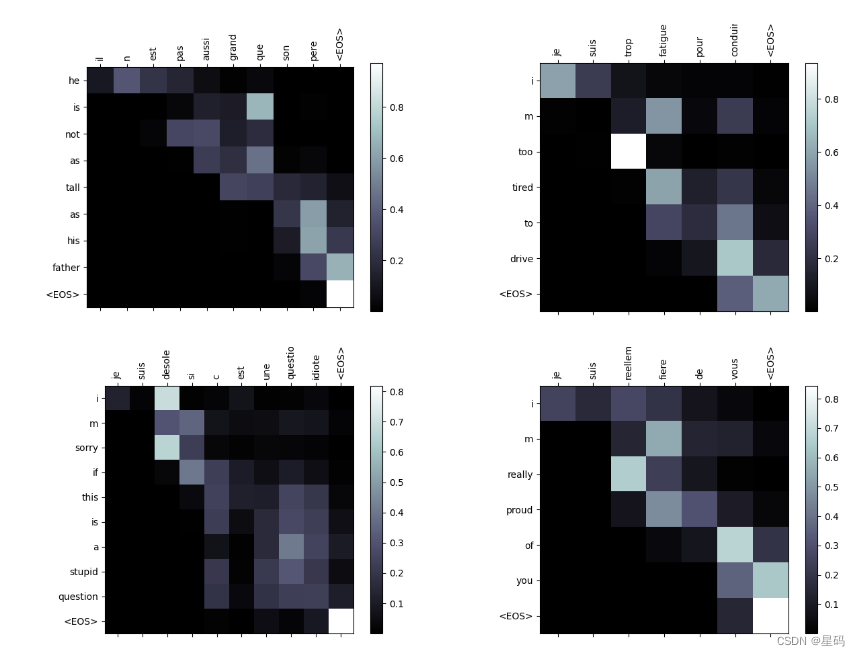
结果
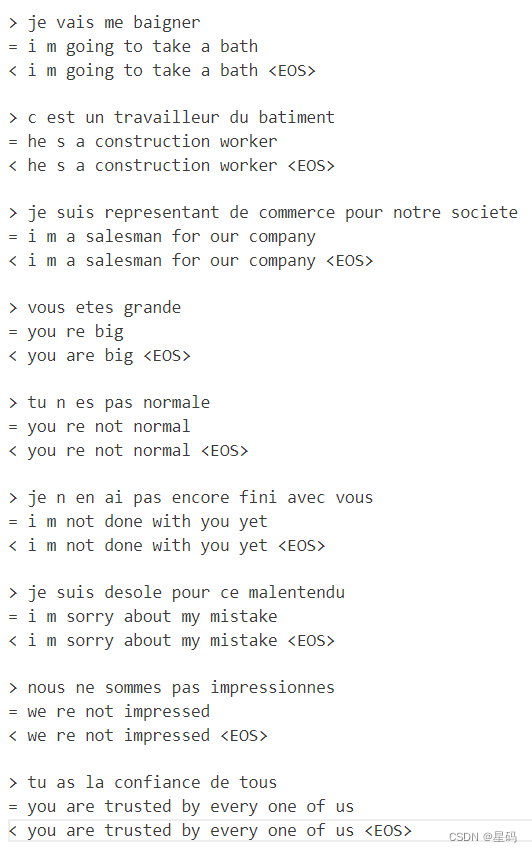
可以发现得到的翻译结果比较好
参考资料
https://pytorch.org/tutorials/intermediate/seq2seq_translation_tutorial.html#


